This is the seventh of a reproduction of a series of historical notes, articles, tracts and academic discourses to recall landmarks in the history of Somaliland from 1884 which highlight events leading to the country’s two independences of 1960 & 1991.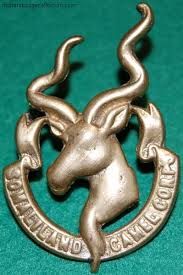
Whilst the defensive infantry battle at Tug Argan Gap is the focal point for many people interested in the brief 1940 campaign in British Somaliland, there are other interesting aspects of British operations that can be deduced from gallantry award citations and military histories. The only local unit involved, The Somaliland Camel Corps (SCC), was involved in several operations elsewhere in the British Protectorate as well as in providing machine gun and rifle platoon support for the infantry battalions fighting at Tug Argan.
The Somaliland Camel Corps in 1939
On the outbreak of war with Germany the SCC was recruited from local Somalis and from Yao tribesmen from Nyasaland (now Malawi) (1).
The unit was organised into; ·
-one motorised machine gun company (‘B’ Company – Yao) ·
-one camel-mounted rifle company (Somali) ·
-one pony-mounted rifle company (Somali) ·
-one dismounted rifle company of mobilised reservists (150 Somalis)
The unit strength, minus the reservists, was 400 Askari and 14 British officers. However as part of British pre-war defence planning measures Southern Rhodesia (now Zimbabwe) had a pool of reservist officers and non-commissioned officers available for posting to other British African units, and 17 officers and 20 other ranks were posted to the SCC from Southern Rhodesia (2). The Rhodesians arrived in late 1939 and this allowed a second SCC dismounted rifle company to be formed.
Lieutenant Colonel A.R. Chater DSO OBE, (Royal Marines), commanded the SCC in 1939 and when he was appointed to be Officer Commanding Troops in Somaliland command of the SCC passed to Lieutenant Colonel R.R. Michell, (Duke of Cornwall’s Light Infantry).
On 10th June 1940 Italy declared war on Britain and France and allied itself with Germany; British Somaliland was immediately threatened by Italian troops occupying Abyssinia to the south and from Italian Somaliland to the east. After wavering for six weeks the adjacent French colony of Djibouti declared for the collaborationist French Vichy regime and accepted an Italian Armistice Commission. This act immediately invalidated British defence planning in Somaliland as there was now no regional ally and the British right flank was unprotected. Nevertheless a decision was made to defend British Somaliland, reinforcements were allocated and a confidential evacuation plan was prepared in case the defence failed. The SCC was also allowed to recruit 50 more soldiers and approval was given to mechanise two of the SCC rifle companies (3).
Somaliland Camel Corps offensive operations
Prior to the Italian invasion and whilst reinforcements were arriving in the Protectorate the SCC, accompanied by Illalo irregulars and Askari from the 1st Battalion the Northern Rhodesia Regiment patrolled the Abyssinian border area south of Hargeisa and Burao. Deep cross-border raiding was not authorised but offensive action against Italian border posts was permitted. A very successful raid was carried out by troops commanded by SCC company commander Lieutenant Gerald Keogh (Rhodesia Regiment). Gerald’s citation for the award of his Military Cross reads:
On the 24th June 1940, BURAMO station was occupied by an Italian Force which included regular troops, armoured fighting vehicles and machine-guns. On 26th June Lieutenant KEOGH was despatched with one camel troop with orders to obtain information regarding the situation at BURAMO and if the circumstances were favourable to carry out a destructive raid. On 27th June the troop arrived in the vicinity of BURAMO and was joined by 40 Illalos (Somali tribesmen). For two days the troop remained in concealment and sent back valuable information. On the night 29/30th June a raid on the station was carried out. The approach of the party was detected by the defenders and heavy fire was opened. Nevertheless the attack was pressed until the buildings occupied by the Europeans were reached. These buildings were attacked with grenades, resulting as has subsequently been ascertained in the death of two and possibly three Europeans. Withdrawal was then carried out in an orderly manner.
Lieutenant Keogh has subsequently carried out another successful night raid against an Italian post at DUMUK. I consider that in organising and leading these raids Lieutenant Keogh has shown marked courage, resource and determination deserving of special recognition. I recommend him for the award of the MILITARY CROSS.
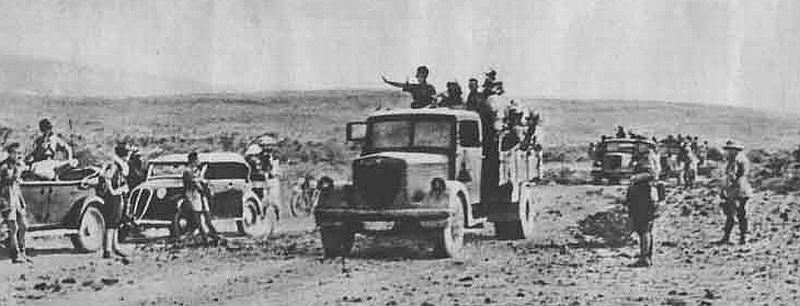
For displaying equal courage, resource, and initiative when engaged on a similar operation No. S.3025 Sergeant David Fleischman (Rhodesia Regiment) was awarded the Military Medal:
For outstanding and conspicuous gallantry during raids at WALID HOR and DAMERABOB when commanding his section covering the withdrawal under heavy fire and carrying to safety for 200 yards a man of his section who had been severely wounded.
During these early days it appears that a force of 500 Abyssinian nationalists from across the southern border was recruited, trained and armed and administered as an attachment to the SCC. Although none of the military histories mention these men a later citation to a Rhodesian non-commissioned officer proves the existence of this force. Meanwhile much administrative and logistical preparation was being carried out within the SCC as this citation for the award of a British Empire Medal to No. 3403/7713 Sergeant John Laird Corrans, Somaliland Force HQ Signal Section (Rhodesia Regiment), shows:
For continuously meritorious service. That communication with outlying detachments was maintained was due largely to the work of this N.C.O., during the months of January to May, when he overhauled and put in order all the obsolete wireless equipment of the Somaliland Camel Corps. Later during the operations he maintained communications at Headquarters under the most adverse conditions.
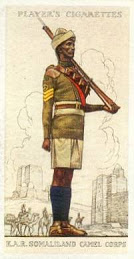
Left: Cigarette-card depiction of Somaliland Camel Corps senior rank.
Somaliland Camel Corps mobile operations during the Italian invasion
On 3rd August 1940 an Italian army under Lieutenant General Guglielmo Nasi invaded the British Protectorate from Abyssinia; Nasi deployed over 20,000 men in three columns. As the SCC fell back from its border patrol positions it harassed each enemy column, assisted by Illalo irregular troops. The westernmost Italian column headed for Zeila on the British Somaliland coast, but did not reach that small port without opposition. A SCC company named NORTHCOL and commanded by Captain Adrian Andrew Brodie Harris-Rivett (35736) (The Bedfordshire and Hertfordshire Regiment) confronted the Italians. Adrian Harris-Rivett’s citation for his Distinguished Service Order tells the story of what his column achieved:
For conspicuous gallant services from 10th June to 15th August 1940 in commanding under most difficult conditions, a column on the right flank of the Force. He, with his company, was situated some 70 miles from the nearest troops and, on his own initiative persistently worried the enemy and reported their strength and movements, until forced to withdraw by the advance of the main columns. When ordered to withdraw, he had to make his way by forced marches, nearly 80 miles to BERBERA. He courageously won his way through to the coast with a small party of Europeans and local Somalis.
Lieutenant H. Addiecott (Rhodesia Regiment) with his No. 1 Troop SCC made a successful raid on the Italian position at Buramo on the border before falling back with NORTHCOL. Eventually Harris-Rivett, acting on orders, disbanded his ‘A’ Company SCC before he and the other Europeans marched to the coast.
By capturing Zeila the Italians had cut-off British Somaliland from Djibouti, and an eastwards advance towards the strategic port of Berbera was now possible. But again sub-units of the SCC were watching and harassing their enemy, as can be seen in this citation for the Distinguished Conduct Medal awarded to No 1096 Sergeant Adan Dualeh, Somaliland Camel Corps.
Somaliland 11th August – 18th August 1940. For highly meritorious service. This Somali NCO showed great devotion to duty throughout the period of operations. During the latter stages he was in charge of the wireless set working with the Somaliland Camel Corps patrol watching the coast road from ZEILA. When the enemy approached he was instructed to move independently from the patrol. He handled his set with skill and courage, and was thereby successful in maintaining contact with both his patrol and Force Headquarters.
Shells from Royal Navy vessels offshore slowed down the enemy advance from Zeila and the Italians were at Bulhar when the British evacuation was completed.
On the British eastern flank Lieutenant (Temporary Captain) Robert Edward Walker Sale (56649), Welsh Guards attached to Somaliland Camel Corps, had been successfully hitting the enemy hard with his SOUTHCOL, as the citation for his Military Cross shows:
For continuous gallantry when in command of a motor company in planning and leading raids over a period of four months. In personally with great bravery and determination leading raids at DAMERABOB on the 15th July 1940 and WALID HOR on 21st July 1940 and on the 13th August leading two troops at night on to the enemy line of communications at DUBATO through most difficult country held by the enemy.
Robert Sale used SOUTHCOL to fight a withdrawal action around Gibileh before withdrawing first through Hargeisa where ‘D’ Company 1st Battalion The Northern Rhodesia Regiment (1 NRR) held an outpost, and then as Italian tanks attacked Hargeisa, back to Tug Argan with the Northern Rhodesians.
In the east ‘C’ Company SCC under Captain O.G. Brooke, Welch Regiment, patrolled from Burao against the Italian right column but the enemy avoided Burao and moved on Adadleh to be nearer the main advance through Hargeisa and Tug Argan. ‘C’ Company withdrew to the Sheikh Pass which was held by the sepoys of ‘B’ Coy 1st Battalion the 2nd Punjab Regiment. When the Punjabis demolished sections of the road through the pass Brooke received sealed orders to disband ‘C’ Company and send the men back to their homes.
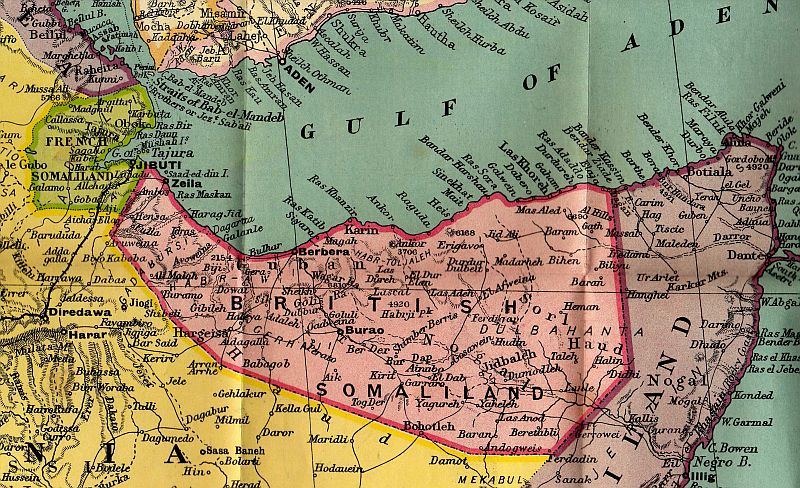
Somaliland Camel Corps defensive actions during the fighting around Tug Argan Gap
Two sub-units of the SCC fought from defensive positions during the fighting around Tug Argan Gap, they were ‘B’ Company (Yao) and the Machine Gun Company. All the SCC troops were on hills defended by the Northern Rhodesians – Black Hill, Mill Hill and Observation Hill; these three hills overlooked the Hargeisa – Berbera road that was the Italian Centre Column axis of advance. The dry watercourse of the Tug Argan and its tributary stream beds meandered just before the defended hills and the Italians made full use of this natural cover.
The flanks of 1 NRR were extended on the right by 3/15th Punjabis and on the left by 2nd Battalion The King’s African Rifles (2 KAR) from Nyasaland and a detached company of 3/15th Punjabis. 2 BLACK WATCH held a reserve position down the Berbera road at Laferug. The British occupied a reasonable defensive position but it lacked extensive wiring, minefields and depth; also the ground on the left flank was very suitable for enemy infiltration. British artillery firepower was limited to the four 3.7-inch howitzers of 1st (East African) Light Battery, plus a naval 3-pounder gun with a crew of three men supplied by HMAS Hobart (4). There was no armoured support and logistic requirements were supplied by convoys composed of rear details from Berbera, 50 kilometres away.
Mill Hill
Early on 11th August Italian artillery bombardments hit the 1 NRR hills first, and then all of the British forward positions. Enemy bombers and ground-attack aircraft then added their support. Mill Hill, where two platoons of ‘B’ Company SCC were dug in, attracted particular enemy attention because two British howitzers were deployed there. By the afternoon of 12th August Mill Hill had become untenable as the defenders had suffered many casualties from artillery fire and infantry attacks. The British howitzers were spiked and abandoned. Withdrawal was organised that night. Two soldiers of the SCC received the Distinguished Conduct Medal for the gallantry that they displayed on Mill Hill.
No 7124 Warrant Officer Class II (Company Sergeant Major) Chikoya, Somaliland Camel Corps:
For continuous gallantry in the face of the enemy from the 11th to 13th August, 1940, during the attack on MILL HILL and the subsequent withdrawal. By his bravery he set an example to the NCOs and men of his company and regardless of danger assisted the British Officers and NCOs in distributing ammunition under heavy fire.
No 11321 Lance Corporal Assan, Somaliland Camel Corps:
For continuous gallantry at MILL HILL in the TUG ARGAN position from the 11th to 13th August 1940. By his bravery and disregard for danger he set an example to his men and at one time when under heavy fire stripped down and cleaned a Bren gun which had stopped firing.
Black Hill
Black Hill, where a detachment of the SCC Machine Gun Company was dug in and supporting the 1 NRR Askari, became isolated during the battle and radio communications were unworkable for a period. This led to the belief that the hill had fallen to the enemy during the night of 13th August. However a patrol from 3/15th Punjabis found the defenders alert and prepared but short of grenades, cartridges for Verey flare pistols, and ammunition. These the patrol was able to supply, as well as a few fresh limes for the parched throats of men who had been carefully conserving the small supply of water on the hill. The Black Hill defenders hung on against strong attacks for a further 48 hours before being withdrawn. Lieutenant R.J.D. Desfountaine, Rhodesia Regiment attached to Somaliland Camel Corps, earned another Military Cross for the SCC:
For meritorious services at BLACK HILL during the battle of TUG ARGAN from the 11th to 15th August, 1940. By his gallant defence of the forward defended location and his personal example of bravery and determination, his post held on till ordered to withdraw. By his skilful handling of his command during withdrawal, 3 medium Machine Guns were brought through the enemy posts to safety. This small post, the most isolated of all, was game to the last.
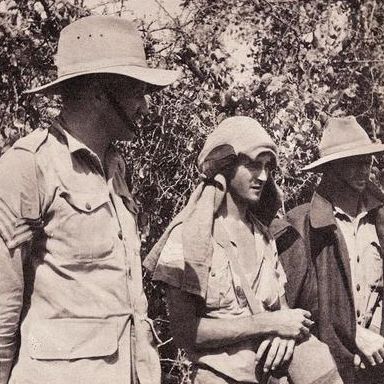 Right: SCC European NCOs taken prisoner by the Italians
Right: SCC European NCOs taken prisoner by the Italians
Observation Hill
Observation Hill attracted heavy enemy artillery fire because of the SCC machine gun detachment and the naval 3-pounder sited on the hill. Both weapons were killing and wounding substantial numbers of Italian troops and disabling armoured fighting vehicles. By 14th August Observation Hill was being shelled from behind as Italian mountain gunners had infiltrated through to the rear of the position. Despite this problem all enemy infantry attacks were successfully driven back until the defence was overcome on the afternoon of 15th August.
Captain Eric Charles Twelves Wilson (The East Surrey Regiment attached Somaliland Camel Corps), was awarded a posthumous Victoria Cross: For most conspicuous gallantry on active service in Somaliland. Captain Wilson was in command of machine-gun posts manned by Somali soldiers in the key position of Observation Hill, a defended post in the defensive organisation of the Tug Argan Gap in British Somaliland. The enemy attacked Observation Hill on August 11th, 1940. Captain Wilson and Somali gunners under his command beat off the attack and opened fire on the enemy troops attacking Mill Hill, another post within his range. He inflicted such heavy casualties that the enemy, determined to put his guns out of action, brought up a pack battery to within seven hundred yards, and scored two direct hits through the loopholes of his defences, which, bursting within the post, wounded Captain Wilson severely in the right shoulder and in the left eye, several of his team being also wounded. His guns were blown off their stands but he repaired and replaced them and, regardless of his wounds, carried on, whilst his Somali sergeant was killed beside him. On August I2th and I4th the enemy again concentrated field artillery fire on Captain Wilson’s guns, but he continued, with his wounds untended, to man them.
On August 15th two of his machine-gun posts were blown to pieces, yet Captain Wilson, now suffering from malaria in addition to wounds, still kept his own post in action. The enemy finally over-ran the post at 5 p.m. on the 15th August when Captain Wilson, fighting to the last, was killed (5).
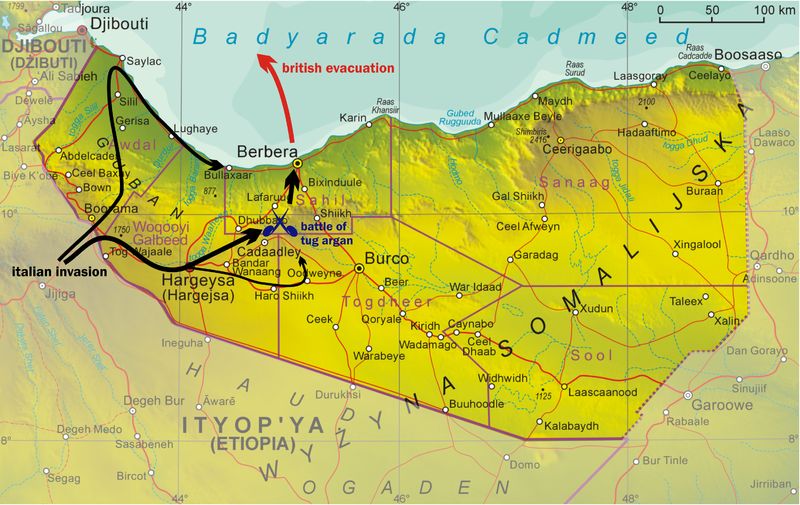
The surviving defenders on Observation Hill attempted to capitulate to the enemy infantry who were now on the crest of the feature, but as the Italians displayed little interest the order was issued to withdraw. A total of 119 men from ‘A’ Company 1 NRR and the SCC got back to the coast from Observation Hill.
Withdrawal and evacuation
The other two howitzers, now almost out of ammunition, had been lost on Knobbly Hill and a Force withdrawal was ordered to Berbera from where evacuation to Aden was being organized by the Royal and Royal Australian Navies. For gallantry displayed during this withdrawal No. CR. 3008 Serjeant Rosslyn Ernest Oliphant, Rhodesia Regiment attached Somaliland Camel Corps, received a Distinguished Conduct Medal:
Sergeant Rosslyn Ernest Oliphant. For conspicuous bravery on the 15th August 1940 after the fall of OBSERVATION HILL at the battle of TUG ARGAN. On finding Sergeant Swimmington of the 1st N.R.R. wounded, he placed him under cover and waited with him till dark. He then assisted Sgt Swimmington out of the position, guided him through the enemy position under heavy machine gun and mortar fire, and brought him back safely regardless of the danger to himself by waiting behind in the captured position, a distance of about 5 miles.
The British units now withdrew, sometimes on foot and crossing enemy lines of communication, back through 2 BLACK WATCH who stoutly resisted an Italian follow-up attack and successfully mounted a company bayonet charge (6). Many of the withdrawing infantrymen had not eaten cooked food for four days. At Berbera the remaining Somali members of the SCC were given the option to be locally discharged with their weapons, and most of the rank and file, but not all, opted to stay in the Protectorate; a few senior ranks were evacuated to Aden (7). The Nyasaland members were amalgamated into 2 KAR. The Illalos melted away back to their tribal pastures.
The evacuation from Berbera proceeded smoothly until the staff remembered the unit of 500 Abyssinian fighters that was stranded 40 kilometres away from Berbera. These men were in immediate danger of being killed by the advancing Italian troops as a civil officer who should have known better had ordered that their weapons be removed and destroyed. An escort party from 1/2nd Punjabis hastened to the Abyssinians and brought them to Berbera.
For his part in this episode NO. CR 276 Company Quartermaster Sergeant Hilton Victor Friend, Rhodesia Regiment attached Somaliland Camel Corps, received a British Empire Medal:
For conspicuously meritorious service C.Q.M.S. Hilton Victor FRIEND was alone in charge of 500 combatant Abyssinians who, on the evacuation of British Somaliland, were situated at BIHENDULA, 25 miles from BERBERA. Through an error of judgement by the civil authorities these men were disarmed and had their arms, their only means of self-defence, broken up under their eyes. Such was the influence of C.Q.M.S. FRIEND over them that he averted any trouble and brought them in perfect order to BERBERA, thence embarked them for ADEN and accompanied them to KENYA. By his determination and coolness he has in almost insufferable circumstances redeemed the pledged word of the BRITISH GOVERNMENT (8).
British casualties during the defence of British Somaliland numbered 260 whilst Italian casualties numbered 2,052.
The sad and ignominious demise of the Somaliland Camel Corps
Six months after evacuating their Protectorate the British returned, and as the Italian East African Empire crumbled the two Punjabi battalions plus Somali and Adeni troops landed at Berbera from Aden to meet up with British forces advancing from Kenya. The SCC was quickly re-formed as an all-Somali unit and employed on its traditional gendarmerie-style duties, both in the Protectorate and in other areas of the former Italian East African Empire that were under British Military Administration (9).
As British operations against the Axis powers developed it was decided to convert the SCC into an armoured car regiment with the intention of training the unit in Southern Rhodesia before deployment to a War Theatre. At this time Lieutenant Colonel A.A.B. Harris-Rivett DSO was the Commanding Officer (10). The intention to serve outside the Protectorate caused unrest not just because of fears that Somali identity and Islamic religious customs would be jeopardized through submersion into a much larger King’s African Rifles regiment, but also because Somali soldiers had traditionally argued that they should serve on terms and conditions equal to Indian Army Sepoys rather than on those that applied to African Askari (11).
Matters culminated in a mutiny at Burao in early June 1944 which led to the final disbandment on 30th September 1944, after 30 years’ of very useful service to the British Government, of the Somaliland Camel Corps (12).
__________________________________________________
SOURCES: (the most economical publishings are shown)
Playfair, I.S.O., Major General: History of the Second World War. The Mediterranean and Middle East, Volume 1.(Naval & Military Press).
Operations in the Somaliland Protectorate, 1939-40. London Gazette Number 37594, Page 2719, Wednesday 5th June 1946.
Awards in recognition of distinguished service in the field in Somaliland, London Gazette Number 35701, Page 811, Tuesday 11th February 1941; and Indian Army Awards, London Gazette Number 35120, Page 1875, 1st April 1941.
Chater, A.R. Major General: Papers in the Liddell Hart Centre for Military Archives, King’s College London.
Lunt, James: Imperial Sunset. Frontier Soldiering in the 20th Century, Chapter 11 – Somaliland Camel Corps and Somaliland Scouts (Macdonald, London 1981).
MacDonald, J.F.: Lion with Tusk Guardant (Southern Rhodesia 1945) (http://archive.org/details/LionWithTuskGuardant )
Moyse-Bartlett, H. Lieutenant Colonel: The King’s African Rifles (Naval & Military Press).
Page, Malcolm: KAR. A History of the King’s African Rifles (Leo Cooper 1998).
Fergusson, Bernard: The Black Watch and the King’s Enemies (Collins, London 1950).
Farndale, Martin, General Sir: History of the Royal Regiment of Artillery. The Years of Defeat 1939-41 (Brassey’s, London 1996).
Betham & Geary: The Golden Galley. The Story of the Second Punjab Regiment 1761-1947. (Oxford University Press 1956).
Hearns, Doug V.P.: Companions of The Distinguished Service Order 1923-2010 (Naval & Military Press).
Brown, George A.: For Distinguished Conduct in the Field. The Register of the Distinguished Conduct Medal 1939-1992(Naval & Military Press).
Fecitt, Harry: The Somaliland Camel Corps, article (http://www.kaiserscross.com/188001/335743.html ).
British National Archives and Commonwealth War Graves Commission records.
Film: The Somaliland Camel Corps Pathe News: http://www.britishpathe.com/video/somali-camel-corps
Film: The British Evacuation of Berbera: http://ww2today.com/19th-august-1940-royal-navy-evauates-british-somaliland
Endnotes
[1] See: Fecitt, Harry: The Somaliland Camel Corps, article (http://www.kaiserscross.com/188001/335743.html ).
[2] Other such postings from Southern Rhodesia were 6 officers and 10 other ranks to the East Africa Army Service Corps, and 151 officers and 237 other ranks to the Royal West African Frontier Force.
[3] These decisions took 6 and 4 months respectively to be approved from London after requests had been submitted.
[4] A detachment from 1st Independent Anti-Tank Troop, ‘P’ Battery, 3rd Royal Horse Artillery, (2 x 37-milimetre Bofors Guns) arrived at the front on 13th August 1940 whilst a Section from 23rd Hong Kong and Singapore Battery, Royal Artillery (2 x 3-inch Anti-Aircraft guns) was deployed at Berbera defending the port.
[5] Eric Wilson VC was later found alive in a prisoner of war camp when British forces captured Italian East Africa, and after overcoming serious wounds he soldiered on to fight in Burma.
[6] For leading this charge Captain D. MacN.C. Rose, Black Watch, was awarded the Distinguished Service Order.
[7] Lord Ismay, a former officer in the SCC during World War I, was to write: This unhappy episode attracted little attention; but to me, with my long association with Somaliland and my affection for her soldiers, it was very painful. The picture of the British officers of my old regiment saying good-bye on Berbera beach to the men whom they had so recently led in battle, and leaving them to fend for themselves, was not a pretty one. Within eight months the Italians were thrown out of the country, and we resumed our responsibilities there. But I wonder whether our prestige in the Horn of Africa has recovered to this day. (The Memoirs of General The Lord Ismay KG, PC, GCB, CH, DSO, Heinemann 1960).
[8] The volunteer Punjabi escort commander, No. 7990 Naik (Corporal) Umansab Khan, received an Indian Distinguished Service Medal and also no doubt the sincere thanks of CQMS Hilton Friend.
[9] Gerald Hanley’s excellent book Warriors and Strangers (Hamish Hamilton paperback, 1987) gives an graphic account of military life in Somaliland after the Italian collapse.
[10] Regrettably Major A.A.B. Harris-Rivett DSO was to be court martialled and cashiered from the British Army in 1955 (London Gazette 9th December 1955 page 6939).
[11] There was some justification for the Somali point of view, as Somali soldiers had always associated closely with Indian Army units that garrisoned the Protectorate (King’s African Rifles units tended to enter the Protectorate for specific operations and then return to their home territories). Also during World War 1 the Arab Rifles (known as ‘Wavell’s Arabs’), raised from Yemenis working on the East African coast, was nominally a King’s African Rifles unit but its soldiers came under the Indian Army Act and not the King’s African Rifles Ordinance. Service under the Indian Army Act allowed for superior scales of pay, equipment and rations.
[12] One newly-raised war-time Somali infantry battalion, 71st Battalion (Somali) King’s African Rifles, did serve in Burma. However the sister 72nd Battalion (Somali) King’s African Rifles, a training and drafting unit, was for a time disarmed and then disbanded in 1945 after serious desertions whilst stationed in Tanganyika Territory and Kenya. A totally new unit, The Somaliland Scouts, was formed on 1st July 1943 from Guard Units that had been raised after the British return to the Protectorate. The Somaliland Scouts served very satisfactorily as an infantry unit until the independence of Somalia in 1960.
Source: Harry’s Africa – Kaisers Cross




























